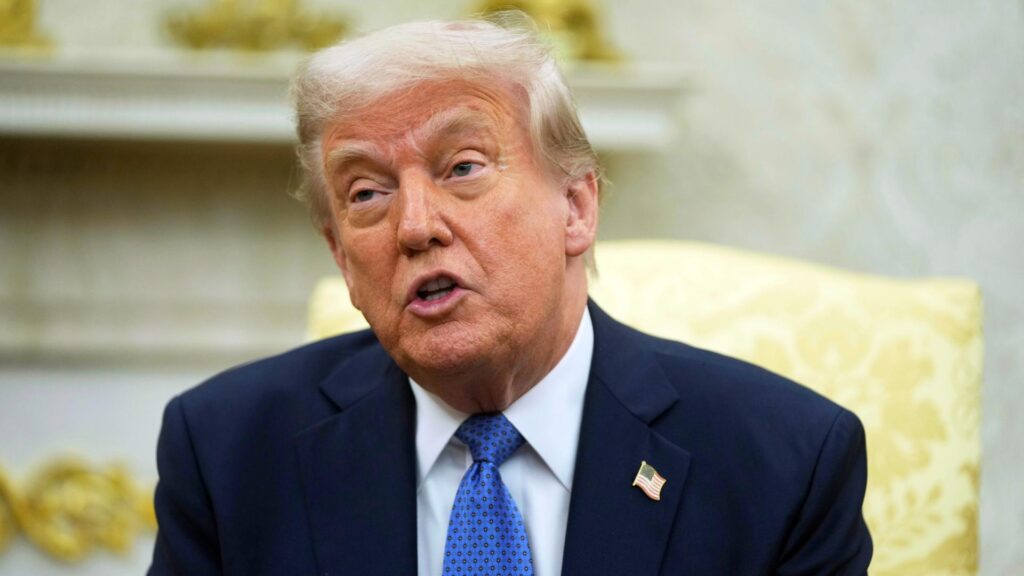In a dramatic turn of economic events, former President Donald Trump has pointed fingers at President Joe Biden amid troubling signs of a recession in the United States. As inflation continues to rise and key economic indicators show signs of deterioration, Trump took to social media and public appearances to express his discontent with the current administration’s handling of the economy. With mounting pressure on the Biden administration to address the challenges facing American families and businesses, the debate over who is to blame for the nation’s economic woes has intensified. This article explores the unfolding narrative, examining Trump’s criticisms, Biden’s response, and the broader implications for the American economy as both politicians gear up for a contentious electoral climate.
Trumps Critique: Analyzing Bidens Economic Policies and Their Impact
As inflation continues to strain American households, former President Trump has stepped up his critique of President Biden’s economic policies, arguing that they are the root of the current economic malaise. The recent rise in consumer prices and escalating interest rates have exacerbated the financial pressures on families and businesses alike. Trump asserts that Biden’s approach, characterized by hefty government spending and regulatory measures, has stifled growth and cultivated an environment ripe for economic contraction. He highlights several key areas where he believes Biden’s policies have faltered:
- Inflation Control: Rising prices on essentials such as groceries and fuel have left consumers disappointed and struggling.
- Job Creation: Critics argue that stagnant job growth under Biden contrasts sharply with the pre-pandemic economic boom.
- Energy Independence: Policies that have restricted domestic oil production are contributing to higher energy costs.
In light of these challenges, Trump emphasizes the importance of adopting more fiscally conservative measures and reducing governmental intervention in the market. He calls for a return to policies that promote deregulation and tax cuts, believing that such strategies will invigorate the economy. To illustrate the economic downturn, the following table summarizes key economic indicators during Biden’s presidency:
| Indicator | Value (Q3 2023) | Change from 2020 |
|---|---|---|
| Inflation Rate | 4.5% | +2.1% |
| Unemployment Rate | 5.2% | +1.0% |
| GDP Growth Rate | -1.3% | -3.0% |
Examining Key Economic Indicators as the U.S. Faces Downturn
As the U.S. economy grapples with signs of a recession, scrutiny has intensified around various economic indicators that could illustrate the nation’s financial health. Notably, GDP growth, unemployment rates, and inflation figures are at the forefront of discussions. The latest statistics reveal a concerning GDP contraction for the past quarter, igniting political debates regarding accountability and economic management. Analysts are particularly focused on:
- Unemployment Rate: Has it ticked upward, signaling job market challenges?
- Inflation Rate: Are price increases continuing to erode purchasing power?
- Consumer Confidence Index: What do surveys reveal about American sentiment regarding spending?
In the arena of consumer confidence, recent data shows a decline as households express apprehension about future finances. Understanding these indicators is pivotal for assessing both the current state and future trajectory of the economy. A brief overview of key indicators from the previous quarter is summarized in the table below:
| Economic Indicator | Current Status | Change from Previous Quarter |
|---|---|---|
| GDP Growth | –0.6% | Decrease |
| Unemployment Rate | 4.2% | Increase |
| Inflation Rate | 6.8% | No change |
| Consumer Confidence | 92.1 | Decrease |
The implications of these economic signals are vast, with potential long-term consequences on consumer behavior, investment strategies, and policy decisions. As political leaders engage in finger-pointing amid this economic turmoil, a careful examination of these indicators will be essential in guiding not only public opinion but also future economic policies.
Strategies for Recovery: Experts Weigh in on Navigating Economic Challenges
As economic pressures mount in the United States, various experts emphasize the importance of adaptive strategies for both governments and businesses. Key recommendations include:
- Investment in Infrastructure: Enhancing the nation’s infrastructure can create jobs and stimulate economic growth. Experts suggest that targeted public projects can serve as a catalyst for recovery.
- Support for Small Businesses: Ensuring that small businesses receive adequate financial support can help maintain employment levels. This includes grants, low-interest loans, and tax relief measures.
- Diversification of Supply Chains: Companies are advised to rethink their supply chains to mitigate risks associated with over-dependence on a few suppliers or regions.
- Focus on Innovation: Investing in technology and innovation can help industries evolve, making them more competitive in a shifting economic landscape.
In addition, experts are advocating for a collaborative approach between the public and private sectors. They highlight the following strategies as vital:
| Strategy | Description |
|---|---|
| Policy Reforms | Reevaluating regulatory frameworks to facilitate business growth and investment. |
| Financial Literacy | Improving economic education to empower citizens and business owners in financial decision-making. |
| Global Partnerships | Engaging in international trade agreements to expand market access for U.S. products. |
To Wrap It Up
the recent economic downturn has become a focal point of political contention, with former President Donald Trump attributing the challenges faced by the U.S. economy to the policies of President Joe Biden. As inflation persists and growth projections dim, both sides of the aisle are grappling with the implications of these economic shifts. Experts warn that political blame games may obscure the complexities of the economic landscape, where global factors, supply chain issues, and unprecedented recovery efforts continue to complicate recovery. As the Biden administration reassesses its strategies in response to the economic headwinds, the dialogue surrounding fiscal responsibility and government intervention will remain a critical issue on the national stage. Moving forward, how each party addresses these economic challenges will likely shape not only the future of the economy but also the political landscape in the lead-up to the 2024 elections.
